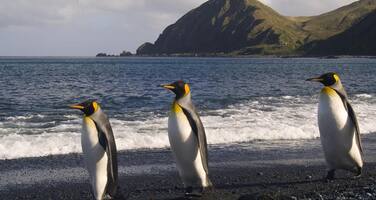Macquarie Island
Factors affecting the property in 2013*
- Fishing/collecting aquatic resources
- Illegal activities
- Invasive/alien terrestrial species
Factors* affecting the property identified in previous reports
- Invasive Species
- Legal and illegal long-line fishing
International Assistance: requests for the property until 2013
Total amount approved : 0 USD
Missions to the property until 2013**
Conservation issues presented to the World Heritage Committee in 2013
On 31 January 2013, a report on the state of conservation of the property was submitted by the State Party. The report gives an overview of the implementation and preliminary results of the Macquarie Island Pest Eradication Plan, the State Party’s findings regarding the dieback of the Macquarie Cushion Plant, and impacts of long-line fishing within and outside the Australian Exclusive Economic Zone around Macquarie Island.
a) Rabbit and rodent eradication
The Macquarie Island Pest Eradication Plan is aimed at the eradication of introduced rabbits and rodents (mice and rats). The State Party reports that no rabbits have been observed since December 2011, and no rodents have been detected since June 2011. Vegetation has been re-established and seabirds returned to breed in previously affected areas.
b) Dieback of Macquarie Cushion Plant
The State Party confirms the progressive dieback of the Macquarie Cushion Plant and attributes it to changes in climatic conditions (increased drying due to greater wind speeds and hours of sunshine) in possible combination with disease. The dieback is reported to be occuring throughout the property. The State Party plans to establish an ex situ orchard in the property, which, together with stored seed, may help to restore populations in the future.
c) Impact of long-line fishing inside the Exclusive Economic Zone around Macquarie Island on seabirds
The State Party recalls its research and bycatch mitigation efforts to reduce the impact of legal and illegal long-line fisheries on seabirds. These efforts are proceeding in cooperation with international organisations and instruments, including the Agreement on the Conservation of Albatrosses and Petrels, the Commission for the Conservation of Antarctic Marine Living Resources, and the relevant regional fisheries management organisations. The State Party indicates that long-line fishing is now authorised inside the Exclusive Economic Zone around the property, following four seasons of long-line trials during which time no seabird by-catch was recorded.
Analysis and Conclusion by World Heritage Centre and the Advisory Bodies in 2013
The World Heritage Centre and IUCN welcome the progress and preliminary results of the Macquarie Island Pest Eradication Planwhich show that no rodents have been detected since June 2011, that the vegetation has been re-established and that seabirds returned to breed in previously affected areas.They also welcome the State Party’s on-going efforts to implement measures to mitigate the dieoff of Macquarie Cushion Plant.
IUCN notes that it will be important that within the foreseen monitoring programme, outcome monitoring will be included, without which it will be difficult to establish the sustainability of the eradication programme and to document the ensuing vegetation recovery.
Summary of the interventions
Decisions adopted by the Committee in 2013
37 COM 7B.11
Macquarie Island (Australia) (N 629 rev)
The World Heritage Committee,
1. Having examined Document WHC-13/37.COM/7B,
2. Recalling Decision 34 COM 7B.10 , adopted at its 34th session (Brasilia, 2010),
3. Expresses its satisfaction about the preliminary results of the Macquarie Island Pest Eradication Plan which show that no rodents have been detected since June 2011, that the vegetation has been re-established and that seabirds returned to breed in previously affected areas and notes the on-going efforts of the State Party to implement measures to mitigate the dieback of the Macquarie Cushion Plant, and to limit impacts of long-line fishing within and outside the Australian Exclusive Economic Zone around Macquarie Island;
4. Welcomes the commitment of the State Party to continue to monitor the results of the Macquarie Island Pest Eradication Plan and requests the State Party to include the monitoring of outcomes to confirm the continued recovery of the property’s vegetation and ecosystems;
5. Also r equests the State Party to keep the World Heritage Centre informed on the progress made in implementing the above recommendations.
Draft Decision: 37 COM 7B.11
The World Heritage Committee,
1. Having examined Document WHC-13/37.COM/7B,
2. Recalling Decision 34 COM 7B.10, adopted at its 34th session (Brasilia, 2010),
3. Expresses its satisfaction about the preliminary results of the Macquarie Island Pest Eradication Plan which show that no rodents have been detected since June 2011, that the vegetation has been re-established and that seabirds returned to breed in previously affected areas and notes the on-going efforts of the State Party to implement measures to mitigate the dieback of the Macquarie Cushion Plant, and to limit impacts of long-line fishing within and outside the Australian Exclusive Economic Zone around Macquarie Island;
4. Welcomes the commitment of the State Party to continue to monitor the results of the Macquarie Island Pest Eradication Plan and requests the State Party to include the monitoring of outcomes to confirm the continued recovery of the property’s vegetation and ecosystems;
5. Also requests the State Party to keep the World Heritage Centre informed on the progress made in implementing the above recommendations.
Exports
* :
The threats indicated are listed in alphabetical order; their order does not constitute a classification according to the importance of their impact on the property.
Furthermore, they are presented irrespective of the type of threat faced by the property, i.e. with specific and proven imminent danger (“ascertained danger”) or with threats which could have deleterious effects on the property’s Outstanding Universal Value (“potential danger”).
** : All mission reports are not always available electronically.


